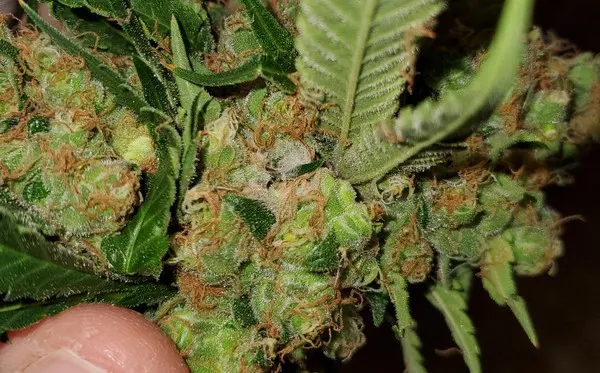When it comes to product that is tested for chemical residues and microbials, it is important for growers to produce clean crops, but it is also of the utmost importance that products they have been using on plants are safe as well. “There is a finite list of what is allowed to be applied to cannabis and industrial hemp,” says Charlie McKenzie, crop consultant with CropWalk. “However, these solutions are only one aspect of how to fight crop disease. The most important things are knowledge of your crop, management of your environment and understanding the ‘disease triangle’.”
Understanding the disease triangle
The disease triangle is a figure that explains how diseases might occur within a crop. “It consists of three elements,” Charlie explains. “On one side, there is the host – the cannabis plant, in this case, which is very susceptible to foliar pathogens. Then, on another side, there is the pathogen itself, i.e. powdery mildew or botrytis. Lastly, the third part of the triangle is represented by the environment: you need to have a hospitable environment for the pathogen to thrive and infect the host, which then results in crop disease”
“When you look at the triangle, if you remove one piece or side of it, you stop the disease.” However, growers cannot remove the cannabis plant from the equation. Therefore, the aspect for a grower to address is both the pathogen and the environment. “Growers can exclude pathogens, with strict sanitation and quarantine protocols for instance; or they can manage the environment and make it unhospitable for the pathogens to infect the host.”
 Botrytis mold on a cannabis flower
Botrytis mold on a cannabis flower
That is why Charlie advises growers to look at every single detail that can influence the environment, and sometimes this goes back to the facility design process. “A potential fix, in a highly controlled indoor or hybrid facility, could be to have some sort of sanitizing or sterilizing equipment implemented directly within the ventilation system, so that spores and pathogens are getting killed before they enter or recirculate through the grow room.”
The important variables
However, there are many different environmental variables that need to be taken into consideration. “The way we have been helping growers is to analyze how the crop’s environment is affected by each of its’ contributing variables and see how they can change those variables to create a less hospitable environment for the pathogen” he explains. “Growers can use a micro-climate sensor, which is going to give them data on certain environmental variables. The variables we routinely monitor are relative humidity, ambient air temperature, leaf surface temperature, crop dew point, and vapor-pressure deficit. When you look at the relationship between the variables, you start to notice trends. In our opinion, one important trend is the relationship between the leaf surface temperature and the dew point. When the leaf surface temperature decreases and gets close enough to the crop’s dew point, an unfavorable microclimate is created on the surface of the leaves, that has just enough moisture for certain pathogens to set in.”
Constant monitoring
Thus, Charlie points out that closely monitoring the environment is crucial to ensure a grower’s success. “For instance, especially during cannabis flowering, we recommend that growers keep their leaf surface temperature at least a few degrees Celsius above the dew point, so they can prevent an unfavorable environment for the pathogen to thrive. Using a range of different technologies, the grower can set up alarms and alerts to warn of a situation where leaf surface temperature is approaching the dew point so they can proactively make modifications to their environment; or if they are using a more advanced environmental controller, they may be able to influence the facility’s environmental control equipment in such a way that it prevents the pathogen-favoring-conditions from ever happening. This is one of the ways you can proactively protect your crop”.
IPM outdoors
Crop protection for cannabis changes whether that is grown indoors and in greenhouses, or outdoors. “When outdoors, it is nearly impossible to control the environment,” says Charlie. “For controlling diseases in an outdoor cultivation, it is crucial to start with a disease-resistant cultivar. For instance, some breeders are working diligently each year to select varieties that show superior disease resistance.”
“The selection of a disease resistant genetic for your cultivation environment and region is the first line of defense. The second one is strategic site evaluation: that is, noting the portions of land where plants have previously been affected by pathogens, and then just avoiding production in those spots. For instance, if outdoor crops are close to ponds, streams, rivers, there is a chance that there is a uniquely moist micro-climate in that portion of the crop, and thus a higher chance for a disease-favoring environment. Those are points to consider when planning the location of your next crop.”
Over the last months, outdoor cannabis growers had to fight with many different enemies. “In the South East hemp crops, for instance, there were cases of diseases like southern blight and cercospora leaf spot; however, in my opinion, the most challenging enemy was fusarium, which affected a large number of growers, to some extent or another.”
Effective solutions
According to Charlie, growing indoors can greatly reduce the risk of your crop being exposed to certain pathogens. “Most of the things that growers are doing indoors are to exclude the opportunity for pathogens to be present in their facility or grow room,” he explains. “They may be doing tissue culture, so they make sure that only healthy and disease-free young plants get into the grow room. On top of that, some of these indoor cultivations follow strict sanitary and process flow protocols, so that they exclude the pathogen as best they can”.
“One effective solution to prevent and even eradicate pathogens is provided by CleanLight,” he says. “Through the consistent and regular application of UV light on the crop and in the facility, pathogens such as botrytis and powdery mildew can be eradicated. There are different sizes and types of CleanLight modules, that can be used to fit the crop production scenario. For instance, some growers install CleanLight modules on irrigation booms or crop trolley’s which run routinely through and over the crop.”
An eye to the future
But the cannabis industry is maturing, and growers are getting increasingly knowledgeable with regards to the weapons they can use to fight pathogens. “I have seen a lot more knowledge sharing happening, recently,” Charlie points out. “There are a lot of conferences and conventions that growers can attend and share their insights between each other. I believe that increasing knowledge sharing is the right approach to allow the sector to advance.”
For more information:
CropWalk
cropwalk.ag
